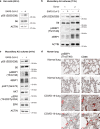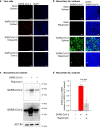SARS-CoV-2 infection rewires host cell metabolism and is potentially susceptible to mTORC1 inhibition
- PMID: 33767183
- PMCID: PMC7994801
- DOI: 10.1038/s41467-021-22166-4
SARS-CoV-2 infection rewires host cell metabolism and is potentially susceptible to mTORC1 inhibition
Abstract
Viruses hijack host cell metabolism to acquire the building blocks required for replication. Understanding how SARS-CoV-2 alters host cell metabolism may lead to potential treatments for COVID-19. Here we profile metabolic changes conferred by SARS-CoV-2 infection in kidney epithelial cells and lung air-liquid interface (ALI) cultures, and show that SARS-CoV-2 infection increases glucose carbon entry into the TCA cycle via increased pyruvate carboxylase expression. SARS-CoV-2 also reduces oxidative glutamine metabolism while maintaining reductive carboxylation. Consistent with these changes, SARS-CoV-2 infection increases the activity of mTORC1 in cell lines and lung ALI cultures. Lastly, we show evidence of mTORC1 activation in COVID-19 patient lung tissue, and that mTORC1 inhibitors reduce viral replication in kidney epithelial cells and lung ALI cultures. Our results suggest that targeting mTORC1 may be a feasible treatment strategy for COVID-19 patients, although further studies are required to determine the mechanism of inhibition and potential efficacy in patients.
Conflict of interest statement
The authors declare no competing interests.
Figures



Similar articles
-
The MEK1/2-inhibitor ATR-002 efficiently blocks SARS-CoV-2 propagation and alleviates pro-inflammatory cytokine/chemokine responses.Cell Mol Life Sci. 2022 Jan 10;79(1):65. doi: 10.1007/s00018-021-04085-1. Cell Mol Life Sci. 2022. PMID: 35013790 Free PMC article.
-
Synergistic Block of SARS-CoV-2 Infection by Combined Drug Inhibition of the Host Entry Factors PIKfyve Kinase and TMPRSS2 Protease.J Virol. 2021 Oct 13;95(21):e0097521. doi: 10.1128/JVI.00975-21. Epub 2021 Aug 18. J Virol. 2021. PMID: 34406858 Free PMC article.
-
APOBEC3G-Regulated Host Factors Interfere with Measles Virus Replication: Role of REDD1 and Mammalian TORC1 Inhibition.J Virol. 2018 Aug 16;92(17):e00835-18. doi: 10.1128/JVI.00835-18. Print 2018 Sep 1. J Virol. 2018. PMID: 29925665 Free PMC article.
-
Inhibitors of endosomal acidification suppress SARS-CoV-2 replication and relieve viral pneumonia in hACE2 transgenic mice.Virol J. 2021 Feb 27;18(1):46. doi: 10.1186/s12985-021-01515-1. Virol J. 2021. PMID: 33639976 Free PMC article.
-
Interactions of SARS-CoV-2 with Human Target Cells-A Metabolic View.Int J Mol Sci. 2024 Sep 16;25(18):9977. doi: 10.3390/ijms25189977. Int J Mol Sci. 2024. PMID: 39337465 Free PMC article. Review.
Cited by
-
White Spot Syndrome Virus Triggers a Glycolytic Pathway in Shrimp Immune Cells (Hemocytes) to Benefit Its Replication.Front Immunol. 2022 Jul 4;13:901111. doi: 10.3389/fimmu.2022.901111. eCollection 2022. Front Immunol. 2022. PMID: 35860260 Free PMC article.
-
The nsp15 Nuclease as a Good Target to Combat SARS-CoV-2: Mechanism of Action and Its Inactivation with FDA-Approved Drugs.Microorganisms. 2022 Feb 1;10(2):342. doi: 10.3390/microorganisms10020342. Microorganisms. 2022. PMID: 35208797 Free PMC article.
-
COVID-19 drug discovery and treatment options.Nat Rev Microbiol. 2024 Jul;22(7):391-407. doi: 10.1038/s41579-024-01036-y. Epub 2024 Apr 15. Nat Rev Microbiol. 2024. PMID: 38622352 Review.
-
Structural Analysis of SARS-CoV-2 ORF8 Protein: Pathogenic and Therapeutic Implications.Front Genet. 2021 Sep 6;12:693227. doi: 10.3389/fgene.2021.693227. eCollection 2021. Front Genet. 2021. PMID: 34552615 Free PMC article. Review.
-
COVID-19 clinical presentation, management, and epidemiology: a concise compendium.Front Public Health. 2025 Jan 31;13:1498445. doi: 10.3389/fpubh.2025.1498445. eCollection 2025. Front Public Health. 2025. PMID: 39957982 Free PMC article. Review.
References
Publication types
MeSH terms
Substances
Grants and funding
LinkOut - more resources
Full Text Sources
Other Literature Sources
Medical
Molecular Biology Databases
Miscellaneous

